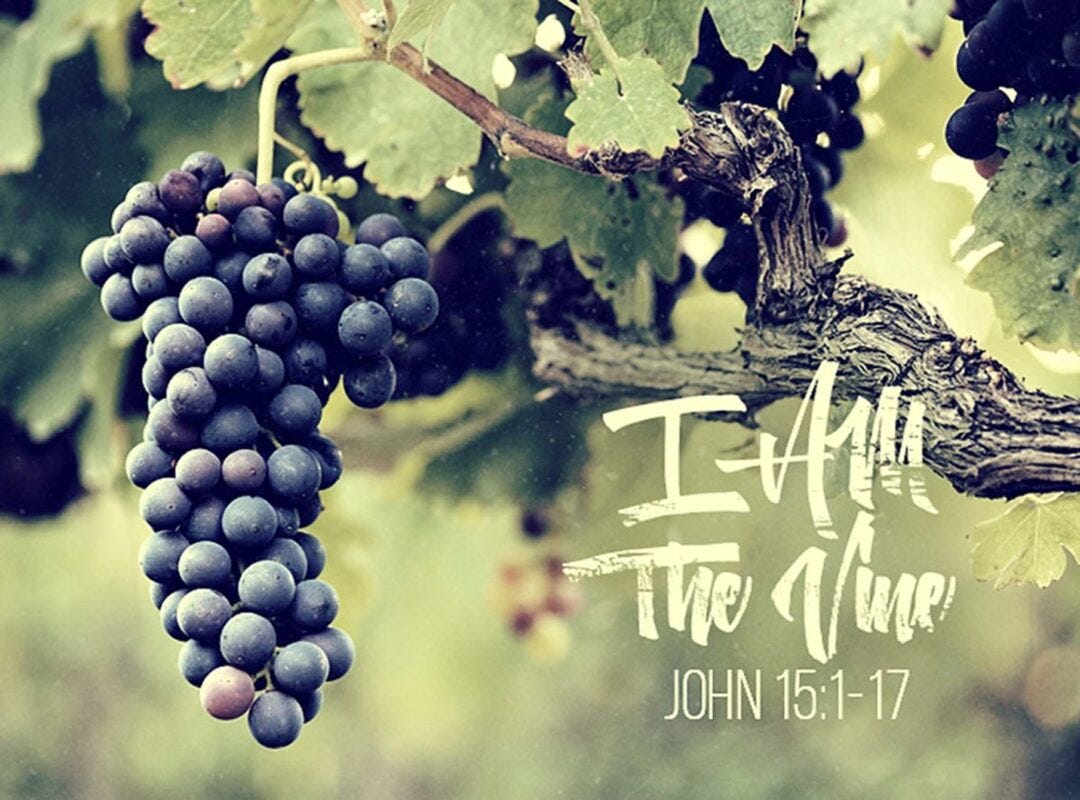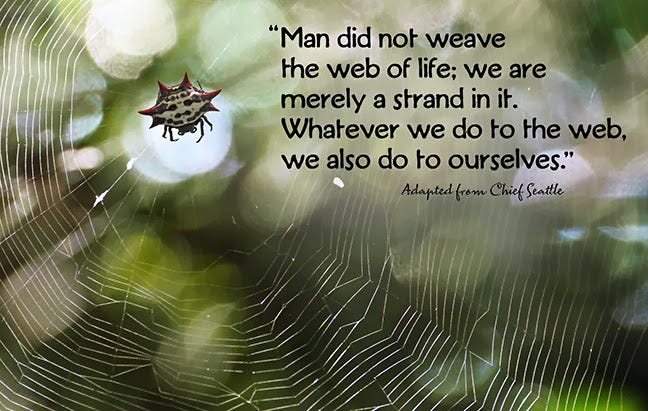The True Vine, The Web Of Life
Illustrating Our Endless Connections
Dear Friends,
Alleluia! He is Risen!
The Lord is Risen Indeed! Alleluia!
It’s still Easter, after all!
Growing up, my grandparents had an absolutely useless grape vine.
Running along a neighbor’s driveway behind the corn “field” (really a very sizable patch), we were lucky to get a few small clusters of miniature, sour green grapes each year. I don’t quite know what the issue was with this vine, or or how fruitful it had been at its best in the years and decades prior, but it was one of a handful of things in that wonderful garden that we just didn’t expect much from. Another was a pear tree; if we got half a dozen pears in a given year, it had done about as well as could be expected. The only reason we even paid these things any mind, I think, was that it would have been more work to get rid of them than to just be pleasantly surprised if anything grew.
I think about those literal sour grapes rather fondly. I liked them better than raw tomatoes or string beans, things my cousins would eat straight from the vine. I enjoyed the absolute surprise of it all. But, gosh, if we were operating by this Sunday’s lectionary, in which Jesus declares, “I am the vine,” those grapes wouldn’t have lasted long.
Every Branch That Bears No Fruit
If we’re being literal here, my grandparents’ grape vine was bearing fruit. Agriculturally, though, the whole situation was pretty meaningless. There weren’t enough grapes in a good year for an after school snack, never mind enough to make jam or press into wine. The Father, the vine grower, I think, would have pruned that grape vine aggressively and, I think, ultimately uprooted it. No part of it was productive enough that it would have escaped the fire.
Of course, in this week’s Gospel reading, there’s no chance the whole plant will be utterly obliterated. That’s because the foundation of the vine is Christ, and we are just the branches. We can be severed from it all, but the vine will remain. There is always another generation in this agricultural metaphor. But let’s take a few step backs.
Spring is breaking out all around the northern hemisphere (where I’m rather confident all of you are), so I wonder what you might see if you took a walk? Maybe you live near houses or a university where ivy overtakes the facades, or maybe there’s clematis in your backyard or along a neighbor’s fence. Perhaps there’s honeysuckle just beginning to bloom along some stairs. The point here is that surely, wherever you are, you can find some vines.
What do you notice?
As someone who used to have a flourishing ivy plant that probably wasn’t repotted as often as it should have been, vines often strikes me a great tangle. There’s no way to distinguish the many branches, no clear path back to the central vine. You could sit for some length of time trying to unthread the various pieces like untangling Christmas lights, only to find yourself no further along. The natural state of vines is to be enmeshed.
Well, guess what? That’s our natural state, too.
I’m quite taken by this icon of Jesus, God the Father (very old man in the sky vibes on his part), and the disciples as the most natural of family trees. Each disciples roots back to Jesus, overseen by God the Father-turned-vine grower. And from and around each disciple, there is much fruit. But where one ends and one begins in those outer branches, it’s impossible to know.
Our Great Entanglement
As we spend another week with Jesus and his “I Am” statements, I think we find ourselves once again in a sort of “brother’s keeper” situation. If Jesus was the Good Shepherd, in last week’s Gospel, he also asked us to be, well, some kind of shepherd – figures somehow responsible for caring for our neighbors.
To be one of the branches of the vine, however, is different. The branch is called to bear fruit or else be cast out, sure. But really, what agency does that branch have? Very little! Except when we consider the messy web of it all.
Imagine a game of pick up sticks. The goal is to remove a given stick without disturbing the others. But once the easy options are eliminated, things wobble. To remove one is to risk others.
This week, with Earth Day in the near rearview mirror, let us think about our entanglements and interdependence. Where are you in the great web? If you actually draw a map, what surprising creatures do you find?
Maybe your web of life begins, at first, to look like the icon above, you are the central vine with your core human connections surrounding you. Or maybe it looks like something out of a child’s science class - you are tied to the food you eat and the food your food eats or the nutrients in the soil.
Maybe your web of life is a great philosophical abyss, not a family tree or a scientific exposition, but more of a butterfly effect, a consideration of the delicate universal network in which we live. What happens when we put our webs side by side?
Resources From The “Web”
This Kickstarter has already hit double its goal, but the folks over at The Bible For Normal People have an ambitious project in the work: a multivocal children’s Bible that addresses some major authorial and philosophical gaps in the storybook Bible space. Now, I don’t normally recommend a Bible that I haven’t taken a look at, but I think even reading the description of the research they did over at Kickstarter is pretty interesting in terms of thinking about what resources are available to us right now. Plus, they’ve pulled in some AMAZING collaborators.
Two week ago I wrote about my “Resurrection Work,” which focused on making some accessibility updates in my parish work space, and it’s well underway! With that work still in mind, I want to share with you the sort of thing I would love to make part of my work eventually via this article from Ability Ministry, on a parish that installed a universal changing table in their accessible bathroom space. If we are going to welcome people with different physical and developmental needs, this is part of the work.
It’s not the same Parable as the True Vine, but this week’s story certainly makes me think of The Good For Nothing Tree by Amy-Jill Levine and Sandy Eisenberg Sasso. The Parable of the True Vine doesn’t tell us how much patience the branches that don’t bear fruit receive, but The Good For Nothing Tree trusts we will all bear fruit in our own time.
I’ll be preaching this Sunday at my home base, Christ Episcopal Church, so drop into the livestream if you’re a church nomad (or for any other reason) – we’d love to have you.
Peace,
Bird






Hello from the Southern Hemisphere (New Zealand to be more precise, where the leaves on our neighbours grapevine are just starting to change colour as we head further into autumn) 😁 Really appreciated your post today, and we’re also in the camp of being excited about the Bible for Normal People kickstarter!